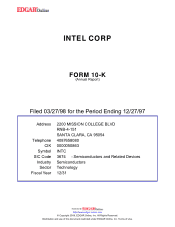Intel 1997 Annual Report Download - page 5
Download and view the complete annual report
Please find page 5 of the 1997 Intel annual report below. You can navigate through the pages in the report by either clicking on the pages listed below, or by using the keyword search tool below to find specific information within the annual report.way for market acceptance of the product. The Company initially offered the Pentium processor with MMX technology at speeds of 200 and
166 MHz for desktop systems and 166 and 150 MHz for mobile computers.
Later in the year, Intel expanded this key product line by introducing new speeds and models. Introduced in June, a 233-MHz Pentium
processor with MMX technology provides a higher-performance option for desktop and server systems. Intel expanded the mobile computing
line with Pentium processors with MMX technology at 133 MHz in May, 233 MHz and 200 MHz in September, and 266 MHz in January
1998, all aimed at notebook computers. The Company also introduced a 120-MHz version in October 1997 and a 166-MHz version in January
1998 designed especially for the mini-notebook computer market segment. The processors optimized for mobile applications consume less
power and come in a smaller package than the desktop/server versions.
Intel also expanded its OverDrive(R) processor family of upgrade microprocessors in 1997. In March, Intel introduced the Pentium Overdrive
(R) processor with MMX technology at speeds of 166, 150 and 125 MHz, and in August Intel announced the addition of 200- and 180-MHz
versions. This OverDrive processor allows computer users to upgrade most older Pentium processor-based systems to take advantage of the
benefits of the MMX media enhancement technology, bringing richer multimedia performance to Pentium processor-based PCs in a single
upgrade chip.
In May 1997, the Company launched the Pentium II processor, a new version of its sixth-generation microarchitecture, which incorporates
MMX technology for optimal media performance and provides more processing power than any other Intel chip to date. Introduced at speeds
of 300, 266 and 233 MHz, the Pentium II processor provides the performance to drive enterprise computing, deliver enhanced capabilities to
small businesses, and power demanding workstation systems. The Pentium II processor's Dual Independent Bus architecture addresses the
bandwidth limitations of previous-generation processor architectures by using two independent buses that can access data simultaneously and
in parallel. The processor also incorporates Dynamic Execution technology, which extends the raw performance of the processor by allowing
more data to be processed in parallel in a given period of time. These advanced technologies enable the Pentium II processor to deliver superior
results in all three key elements of microprocessor performance:
floating point, multimedia and integer calculations. In January 1998, Intel introduced its fastest microprocessor to date, the 333-MHz Pentium
II processor.
Intel also introduced a new version of its Pentium Pro microprocessor running at 200 MHz, with one megabyte of integrated Level 2 cache,
compared to 512 kilobytes of Level 2 cache in previous versions. As the larger Level 2 cache improves the performance of the processor in
multiple-processor systems, this new Pentium Pro processor is targeted for multiprocessing servers and it offers Intel's highest performance for
four-way processor and higher based enterprise server systems.
While many of Intel's original equipment manufacturer (OEM) customers use the Company's microprocessors as components in designing their
own computer products, some OEMs use Intel-designed board-level products as basic building blocks in their computer products. OEM
customers may buy at this level of integration to accelerate their time-to-market and to direct their investments to other areas of their product
lines. The Company provides board-level products to give OEM customers flexibility by enabling them to choose whether to buy at the
component or board level.
Sales of Pentium family microprocessors and related board-level products comprised a majority of the Company's revenues and gross margin
during 1997. During 1996 and 1995, a majority of the Company's revenues and a substantial majority of its gross margin were derived from
these products. Sales of Pentium Pro and Pentium II microprocessors became an increasing portion of the Company's revenues and gross
margin in 1996 and a significant portion in 1997. The Intel486(TM) microprocessor family contributed significant but declining revenues and
gross margin in 1995 and negligible revenues and gross margin in 1996.
In 1997, the Company announced that the first member of its new family of 64-
bit microprocessors, the Merced(TM) processor, is scheduled to
ship in 1999. The Merced processor will extend the Intel Architecture with new levels of performance and features for the server and
workstation market segments, while still running all the software that currently operates on 32-bit Intel processor-based machines. During the
past two years, Intel has been working with industry leaders to create operating systems, applications software and systems that will capitalize
on the new IA
-
64(TM) architecture.


















